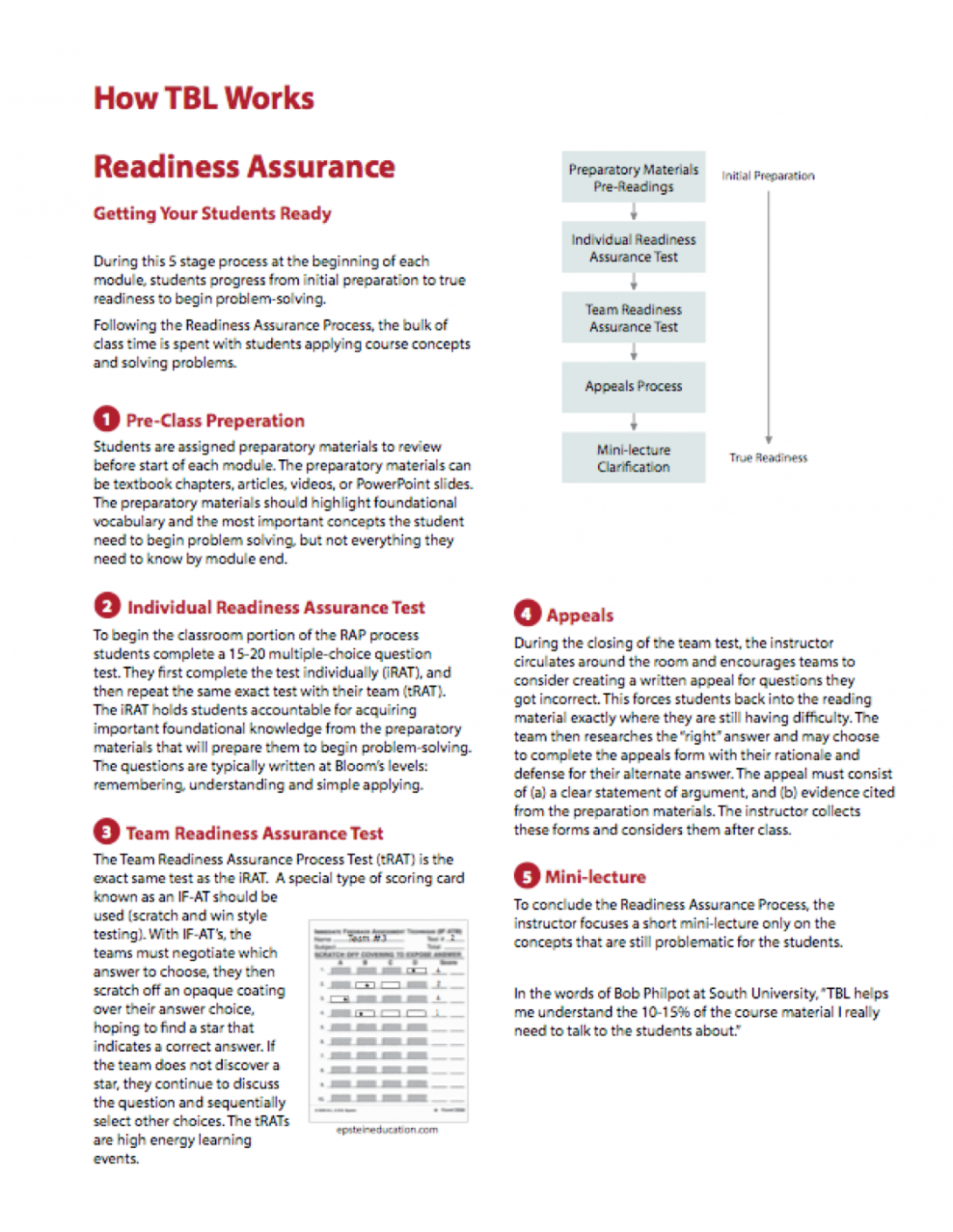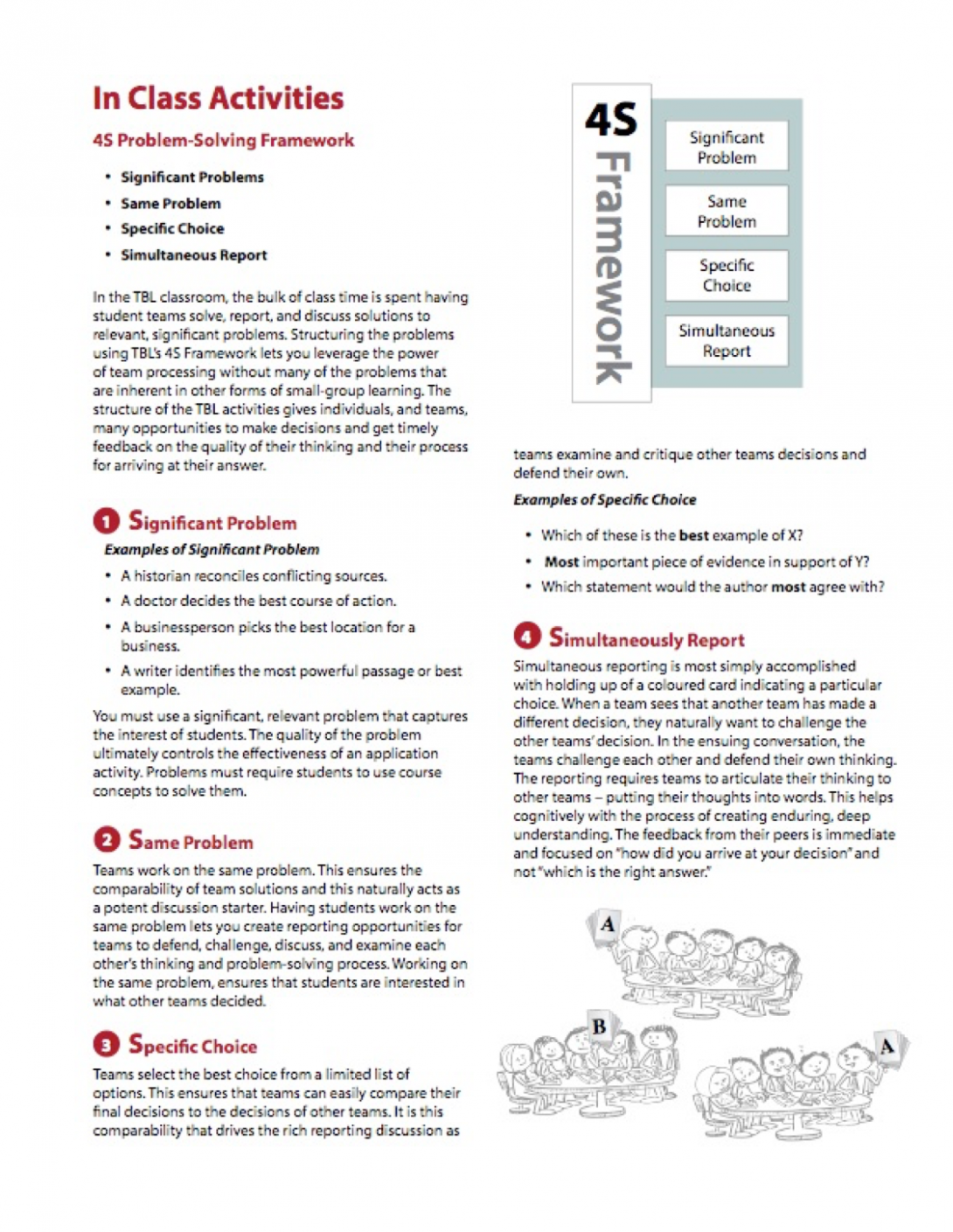Designing and Delivering a TBL Module
Designing a TBL Module: A Working Template for Faculty Heading link
UICOM has subscribed to the Team-Based Learning Collaborative (TBLC) for various members of the faculty and staff for the three campuses. The subscription gets you access to certain parts of the website that are not accessible without a login. Contact your local administration if you do not have an account, and feel that you should have one due to your work with TBLs. The TBLC is an invaluable resource for designing and delivering TBL modules. For a brief overview, you can read the FAQs.
In 2011, some of the top leaders in TBL design and delivery wrote a brief summary and you can find that below.
TBL Summary
Developed by Paul G. Koles, MD; edited by B. Laurel Elder PhD and Dean X. Parmelee MD – revised May, 2011
Designing a TBL module involves 5 essential considerations, and then the design of a module follows a sequence that transforms all 5 of these considerations into learning activities:
Of all the learning objectives for the course, which ones are absolutely essential for students to be successful in medicine?
- Choose from the comprehensive course learning objectives a single objective that is among the “absolutely essential” objectives
Of all topics (content domains) in the course, which are most closely related to these absolutely essential learning objectives?
- Identify a topic (content domain) that is relevant to this essential learning
What do I want the students to be able to do as a result of the module I am designing? (specific action-based learning objectives)
- Develop a set of very specific action-based learning objectives for this module, detailing behaviors that I expect my students to demonstrate by the end of the TBL
Which kinds of application exercise formats are best suited for students to practice the behaviors specified in the learning objectives for this module?
- Choose an application exercise format (case-based, research study-based, experimental vignette with data, public health issue, professional dilemma, or other authentic situation) that provides a structure for organizing and sequencing questions that require critical thinking. With an appropriate format and well-crafted questions, the application exercise becomes a learning laboratory for practicing behaviors that fulfill the learning objectives.
- Create an outline of the application exercise using the chosen format, then write several rough draft questions. Include supporting materials that provide necessary information for interpretation of each question (Example: clinical laboratory data is provided for a question about a patient’s fluid and electrolyte status.)
- Submit the draft application exercise (fleshed-out format and rough draft questions) to two colleagues who are experts in the content domain OR experienced in team-based learning OR expert in writing multiple choice questions. Ideally, the chosen colleagues will possess a combination of these skills. After discussing their critiques and suggestions, revise the draft questions and supporting materials.
Which kinds of knowledge are necessary for the students to master before participating in the readiness assurance process and application exercise?
- Define an advance assignment, at the appropriate level for your learners that will provide a knowledge base that enables students to evaluate the application exercise questions.
- Write the RAT questions, focusing on assessment of critically important knowledge in the advance assignment. Avoid questions on minor, trivial, or obscure points.
Submit the whole module (advance assignment, RAT, and application exercise) to the same two colleagues who reviewed the rough draft application exercise. Discuss their editorial suggestions and revise the module again.
Field test the new module with your students in a graded TBL session.
Within 5 days after the field test, revise the RAT and application exercise, focusing on improving 3 kinds of questions:
- ones with construction flaws that add irrelevant difficulty to the question
- ones that were answered correctly by >90% of students in the IRAT
- ones that were answered correctly by all teams in the application exercise
References
Fink, D. (2003). Creating significant learning experiences: An integrated approach to designing college courses. San Francisco: Jossey-Bass.
Fink, D. (nd). A Self-Directed Guide to Designing Courses for Significant Learning.
Michaelsen, , & Sweet, M. (2008). The essential elements of team-based learning. New Directions for Teaching and Learning, 116. San Francisco: Jossey-Bass.
Michaelsen, K., Knight, A. B., Fink, L. D. (2004). Team–based learning: A transformational use of small groups in college teaching. Sterling, VA: Stylus Publishing.
Wiggins, G. P., & McTighe, H. (2005). Understanding by design, (2nd ed). Association for Supervision and Curriculum Development.
Introduction to Team-based Learning Heading link

“Introduction to Team-based Learning” from the University of British Columbia
Further Reading Heading link
If you want to learn more about TBL, here is a list of resources to check out.
- EDUCAUSE – Team-Based Learning Revisited (2019) https://er.educause.edu/blogs/2019/6/team-based-learning-revisited
- Gomez, E.A., Wu, D., & Passerini, K. (2010). Computer-supported team-based learning: The impact of motivation, enjoyment and team contributions on learning outcomes. Computers & Education, 55, 378-390. Click here for article
- Haave, N. (2014). Team-based learning: A high-impact educational strategy. The National Teaching & Learning Forum, 23(4), 1-4. Click here for article
- Haidet, P., et al. (2012). Guidelines for reporting team-based learning activities in the medical and health sciences literature. Academic Medicine, 87(3), 292-299. Click here for article
- Koles, P.G., Stolfi, A., Borges, N.J., Nelson, S. & Parmalee, DX. (2010). The impact of team-based learning on medical students’ academic performance. Academic Medicine, 85, 1739-1745. Click here for article
- Letassy, N.A., Fugate, S.E., Medina, M.S., Stroup, J.S., & Britton, M.L. (2008). Using team-based learning in an endocrine module taught across two campuses. American Journal of Pharmaceutical Education, 75(2), 1-6. Click here for article
- Levine, R.E., Kelly, P.A., Karakoc, T., & Haidet, P. (2007). Peer evaluation in a clinical clerkship: Students’ attitudes, experiences, and correlations with traditional assessments. Academic Psychiatry, 31(1), 19-24. (Not available online)
- Michaelsen, L.K. & Richards, B.F. (2005). Drawing conclusions from the team-based learning literature in health-sciences education: A commentary. Teaching and Learning in Medicine, 17(1), 85-88. Click here for article
- Parmelee, D.X. (2009). Medical students’ attitudes about team-based learning in a pre-clinical curriculum. Medical Education Online, 14, 1-7. doi: 10.3885/meo.2009.Res00280. Click here for article
- Parmelee, D.X. (2010). Team-based learning: Moving forward in curricular innovation: A commentary. Medical Teacher, 32, 105-107. Click here for article
- Parmelee, D.X., and Michaelsen, L.K. (2010). Twelve tips for doing effective team-based learning (TBL). Medical Teacher, 32, 118-122. Click here for article
- University of Texas at Austin. (n.d.). Team-based learning: Group work that works. Retrieved from http://www.utexas.edu/academic/ctl/largeclasses/#tbl
- VCU SOM iTeach. (2014). Team-based learning: Dr. Stephanie Call. Retrieved from https://www.youtube.com/watch?v=XHJUTUgBVaE&feature=youtu.be
- Whitley, H. P., Bell, E., Eng, M., Fuentes, D. G., Helms, K. L. Maki, E. D., & Vyas, D. (2015). Practical team-based learning from planning to implementation. American Journal of Pharmaceutical Education, 79(10).
Many more research articles can be found here.


